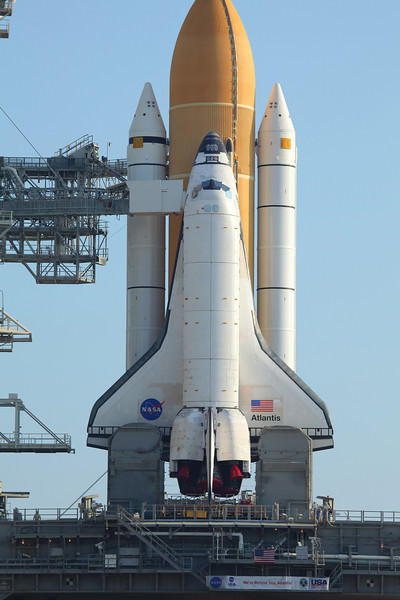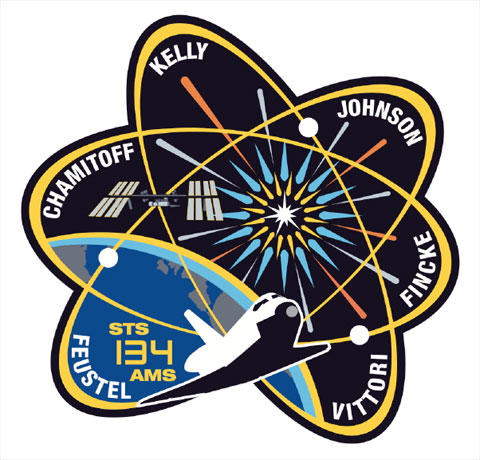[/caption]
A switch-out of the magnet for a much anticipated particle physics experiment on the International Space Station will force NASA to delay the final flight of the space shuttle until at least November, and change which orbiter and crew will fly the final space shuttle mission. The $2 billion Alpha Magnetic Spectrometer was scheduled to head to the ISS in July of this year, but recent thermal vacuum tests showed the superconducting magnet that was originally planned to power the experiment would have only worked 2-3 years. An ordinary magnet, which doesn’t need to be super-cooled will last for a decade or more – and given the ISS has been given a longer life, it seems to be the best option. “I don’t think it’s correct to go there for three years where there is a chance to do physics for 18 years,” said Dr. Samuel Ting, AMS Principal Investor, in an article in the New York Times.
NASA officials said today they still are evaluating the exact day in November, as they must schedule the mission to fit around other resupply and crew flights to the ISS, with the Russian Progress and Soyuz vehicles.
The AMS is designed to search for various types of unusual matter by measuring cosmic rays, and will help researchers study the formation of the universe and search for evidence of dark matter and antimatter.
Changing the magnet means the AMS won’t arrive at Kennedy Space Center before August and shuttle workers need time to get the payload ready to fly inside the shuttle’s cargo bay.

The upcoming flight of the shuttle Atlantis (STS-132) remains on schedule for launch no earlier than May 14. But Endeavour was scheduled for the AMS flight in July, which will now move to no earlier than November. Discovery’s STS-133 flight (bringing up the Leonardo MPLM as a permanent storage module) stays on the schedule for September 16. So while the schedule changes, numerical order is restored!
Another possible change to the shuttle schedule would be if the decision to fly what is called STS-335, the Launch On Need mission, a shuttle ready to go as a rescue ship for the last scheduled mission. Many shuttle supporters say since Atlantis would be ready to fly that it should fly. No decision has yet been made, however.
Even if the final flight or flights get delayed into 2011, funding is not a problem, as Congress anticipated possible delays and provided funds for shuttle operations into early next year.
Liquid helium would have been used cool the superconducting magnet’s temperature to near absolute zero. But tests showed the helium would dissipate withing 2-3 years, leaving the seven-ton experiment useless. The ISS has been extended to at least 2020, and possibly as long as 2028.
Sources: New York Times, Orlando Sentinel


“STS-335, the Launch On Need mission..” Hmm.. dint know that… What would be way double extre groovy cool would be to refit and attach either the Raffaello or Donatello MPLM’s for permanent expansion of the ISS – why not? A guest room?
Would also like to see the Raffaello and Donatello MPLM’s attached to a JAXA HTV and retrofitted to serve as a Lunar Space Station (LSS) – but I’m a dreamer….
Why did they plan it with a superconducting magnet in the first place when an ordinary magnet would have done the job? I guess an ordinary magnet should be much cheaper than a superconducting one.
Strange. Someone please enlighten me!
“STS-335, the Launch On Need mission, a shuttle ready to go as a rescue ship for the last scheduled mission.” I didn’t know about this one either.
If this mission should get the go-ahead, there would be no Launch On Need mission on hand as a possible rescue ship for it, unless of course Discovery were to be readied as STS-336 on standby, which itself “should fly since it would be ready to fly”……
Who says the shuttle programme is coming to an end!
DrFlimmer….
From the New York Times:
…The new magnet is only one-fifth as strong as the superconducting one, but Dr. Ting said the much longer running time of the experiment along with rearranging some of the layers of silicon that record tracks of particles would more than compensate for the weaker magnet.
Hope this answered your question.
Don’t forget, prior to Obama’s decision in February, the ISS was scheduled to be decommissioned in 2015. So the AMS only needed to work for a few years. Now that ISS is scheduled (rightly) to continue operation at least another five years, it makes sense to reconfigure the AMS to work a lot longer.
Go to the AMS page/link above and you’ll see that the superconducting magnet was also supposed to test the feasibility of using a similar magnet for deflecting cosmic radiation around crewed modules… What happened to that?
Quote “But tests showed the helium would dissipate within 2-3 years, leaving the seven ton experiment useless”
Yeah but Helium is a relatively inexpensive commodity that can easily be flown to the ISS where the AMS can be topped up as needed.
If they don’t know how to do that yet, they should get cracking on developing the technique because the know-how can be leveraged to solving similar issues arising from dissipating cryogenics on other spacecraft. For example there are some very expensive IR telescopes in orbit whose life times could be extended by having their cryogenic systems resupplied with Helium possibly via a docking X-37B or similar. It is highly desirable to solve the problem of resupplying cryogenics and considering that automated docking is already well understood (e.g. the Progress cargo vessel), a method should be within easy reach.
When these cryogenic resupply missions become regular, they can then be offered to the commercial sector, freeing NASA to do new, less mundane things.
Sometimes, it seems as though NASA gets lost in the detail, such as the magnet issue effecting the life time of one experiment, when they should just stand back and take in the big picture and realize there is an opportunity to prolong the working life of a fleet of valuable science assets.
I wonder what equiment the payload of a “Launch On Need mission, a shuttle ready to go as a rescue ship” is? Are there special tools available? Is there additional fuel/battery/oxygen on board? Repair kits? For what scenarios is such a ship readied? And the crew also: what special training did the crew receive to be prepared to save another marooned crew?
An interessting topic, I think. But so less information available.
The source documents make for astonishing reading.
a) At over $1.5 billion, the AMS experiment has cost as much as building the shuttle Endeavour! Since AMS started back in 1994, the project been going for nearly as long as Endeavour has been flying.
Two questions…
a.1) Now that AMS is using a cheaper magnet do we get a refund?
a.2) Which would you rather have had, the AMS or a replacement shuttle for Challenger and Columbia?
b) Some die hards are talking up the possibility of STS-335, a victory lap for Atlantis, because there is a spare $600 million lying about to cover potential shuttle operations in the first quarter of fiscal year 2011, just in case it’s needed.
Conclusion. Don’t let anyone tell you the space program is short of a few sheckles. It’s one big orgy of spending.